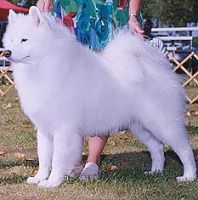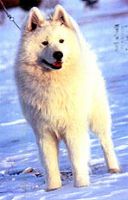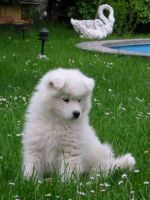SAMOYED (Samoiedska´a Sabaka)


FCI-Standard N°212 / 09. 01. 1999 / GB
ORIGIN : Northern Russia and Siberia.
PATRONAGE : Nordic Kennel Union (NKU).
DATE OF PUBLICATION OF THE ORIGINAL VALID STANDARD : 22.07.1997.
UTILIZATION : Sledge- and companion dog.
CLASSIFICATION F.C.I. : Group 5 Spitz and primitive types.
Section 1 Nordic sledge dogs.
Without working trial.
BRIEF HISTORICAL SUMMARY : The name Samoyed derives from the Samoyed Tribes in Northern Russia and Siberia. In Southern parts of the area they used white, black and brown parti-coloured dogs as reindeer herders ; in the northern parts the dogs were pure white, had a mild temperament and were used as hunting- and sledge dogs. The Samoyed dogs lived close to their owners, they even slept within the shelters and were used as heaters. The British zoologist Ernest Kilburn Scott spent three months among Samoyed Tribes in 1889. Returning to England he brought with him a brown male puppy called « Sabarka ». Later he imported a cream coloured bitch called « Whitey Petchora » from the western side of the Urals and a snow white male called « Musti » from Siberia. These few dogs and those brought by the explorers are the base for the western Samoyed. The first standard was written in England in 1909.
GENERAL APPEARANCE : Medium in size, elegant, a white Arctic Spitz. In appearence gives the impression of power, endurance, charm, suppleness, dignity and self-confidence.
The expression, the so called « Samoyed Smile », is made up of a combination of eye shape and position, and the slightly curved up corners of the mouth. The sex should be clearly stamped.
IMPORTANT PROPORTIONS : The length of the body is approximately 5% more than the height at the withers. The depth of the body is slightly less than the half of the height at the withers. The muzzle is approximately as long as the skull.
BEHAVIOUR AND TEMPERAMENT : Friendly, open, alert and lively. The hunting instinct is very slight. Never shy nor aggressive. Very social and cannot be used as guard dog.
HEAD : Powerful and wedge-shaped.
CRANIAL REGION :
Skull : viewed from the front and in profile only slightly convex. Broadest between the ears. Slightly visible furrow between the eyes.
Stop : Clearly defined but not too prominent.
FACIAL REGION :
Nose : Well developed, preferably black. During some periods of the year the pigment of the nose can fade to a so called « winter nose » ; there must however always be dark pigment at the edges of the nose.
Muzzle : Strong and deep, approximately as long as the skull, gradually tapering towards the nose, neither snipey nor heavy and square. The bridge of the nose is straight.
Lips : Close fitting, black and rather full. The corners of the mouth are slightly curved forming the characteristic « Samoyed Smile ».
Jaws/Teeth : Regular and complete scissor bite. The teeth and the jaws are strong. Normal dentition.
Eyes : Dark brown in colour, well-set in the sockets, placed rather apart, somewhat slanting and almond-shaped. The expression is « smiling », kind, alert and intelligent. The eyerims are black.
Ears : Erect, rather small, thick, triangular and slightly rounded at the tips. They should be mobile, set high ; due to the broad skull well apart.
NECK : Strong and of medium length with a proud carriage.
BODY : Slightly longer than the height at the withers, deep and compact but supple.
Withers : Clearly defined.
Back : Of medium length, muscular and straight ; in females slightly longer than in males.
Loin : Short, very strong and defined.
Croup : Full, strong, muscular and slightly sloping.
Chest : Broad, deep and long, reaching almost to the elbows. The ribs are well sprung.
Underline : Moderate tuck-up.
TAIL : Set rather high. When the dog is alert and in motion the tail is carried bent from the root forward over the back or side, but may be hanging at rest, then reaching to the hocks.
LIMBS
FOREQUARTERS :
General appearance : Well placed and muscular with strong bones. Viewed from the front straight and parallel.
Shoulder : Long, firm and sloping.
Upper arm : Oblique and close to the body. Approximately as long as the shoulder.
Elbow : Close to the body.
Carpus : Strong but supple.
Metacarpus (Pastern) : Slightly oblique.
Fore Feet : Oval with long toes, flexible and pointing straight forward. Toes arched and not too tightly knit. Elastics pads.
HINDQUARTERS :
General appearance : Viewed from GO BACK TO LIST straight and parallel with very strong muscles.
Upper thigh : Of medium length, rather broad and muscular.
Stifle : Well angulated.
Hocks : Rather low and well angulated.
Metatarsus : Short, strong, vertical and parallel.
Hindfeet : As front feet. The dewclaws should be removed.
GAIT : Powerful, free and tireless in appearance with long stride. Good reach in the forequarters and good driving power in the hindquarters.
COAT
HAIR : Profuse, thick, flexible and dense polar coat. The Samoyed is a double coated dog with short, soft and dense undercoat and longer, more harsh and straight outer coat. The coat should form a ruff around the neck and shoulders framing the head, especially in males. On head and on front of legs, hair is short and smooth ; on outside of ears short, standing off and smooth. Inside the ears should be well furred. On back of the thighs the hair forms trousers. There should be a protective growth of hair between the toes. The tail should be profusely covered with hair. The coat of the female is often shorter and softer in texture than that of the male. The correct coat texture should always have a special glistening sheen.
COLOUR : Pure white, cream or white with biscuit. (The basic colour to be white with a few biscuit markings.) Should never give the impression of being pale brown.
SIZE :
Height at withers : Ideal height : male 57 cm with a tolerance of ± 3 cm and females 53 cm with a tolerance of ± 3 cm.
FAULTS : Any departure from the foregoing points should be considered a fault and the seriousness with which the fault should be regarded should be in exact proportion to its degree.
- Visible faults in structure.
- Light bone.
- Males not masculine and females not feminine.
- Pincer bite.
- Yellow eyes.
- Soft ears.
- Barrel ribcage.
- Double twisted tail.
- Low on the legs.
- Badly bow-legged or cow hocked.
- Wavy or short coated throughout, long, soft or coat hanging down.
- Aloofness.
SERIOUS FAULTS :
- Clearly unpigmented areas on eyerims or lips.
ELIMINATING FAULTS :
- Aggresive or overly shy.
- Eyes blue or of different colours.
- Overshot or undershot bite.
- Ears not erect.
- Coat colour other than permitted in the standard.
Any dog clearly showing physical or behavioural abnormalities shall be disqualified.
N.B. : Male animals should have two apparently normal testicles fully descended into the scrotum.
Automatic translate from inseparabile.com
origin:
Russia of the north and siberiasupporter: nordic kennel union (nku)
date of publication of the standard originates them valid: 22.7.1997
I use: dog from slips and company
classification f.c.i.: group 5 spitz and types primiti to you sez. 1 dogs from slips Nordic without job test

short historical signals: the name samoiedo derives from the trib of the siberia and the north of Russia. in the zones to south of the region dogs used themselves white men, black, and pezzati browns in order to lead the reindeers; in the north of the region the dogs were completely white men had a mild character and were employ to you as dogs from hunting and from slip. the dogs samoiedo lived to tightened contact with the owners sleeping in the shelters with they that they used them also in order to heat itself. the British zoologo ernest kilbur scott three months between the trib passed in 1889 samoiedo, to the return in England port with s cucciolo a male of color called brown sabarka. subsequently import one female color cream called whitey petchora from the western depositor of the urali and a male white man snow from the called siberia musti. these little dogs and those little capacities from the exploratory ones are the base of the samoiedo western. the first standard was written up in England in 1909.
general aspect: one spitz Arctic white man, elegant of medium ransom. laspetto d limpressione of force, resistance, fascination, agilit, dignit and emergency of s. lespressione, call "smile of the samoiedo", constituted from one combination of shape and position dellocchio, and from the light curving towards lalto of the angles of the mouth. the sex of the subject would have clearly to be distinguibile.
SUGGESTED BREEDINGS by MENANDPETS.COM:
No breeding to signal
if you want to know like signaling yours, contacts: marketing@inseparabile.it
important proportions: the length of the log approximately 5% greater dellaltezza to the garrese. the profondati ones of the leggermente inferior log to met the dellaltezza to the garrese. the long snout approximately how much the skull.
behavior and character: friendly, open, alert and lively. listinto venatorio much weak person. never timid of aggressive. much sociable one and pu not to be employed like dog from guard.
head: powerful of shape to wedge.
cranial region:
skull: approval of forehead and profile only leggermente convex. devout wide between the ears. leggermente visible I furrow between the eyes.
stop: very marked but not too much pronounced.
region makes them:
tartufo: very marked preferibilmente black. during some periods dell year the pigment pu to fade until the so-called one "tartufo dellinverno", us must however be always dark pigment to the margins of the tartufo.
snout: and strongly deep, along approximately how much the skull, gradually streamlined in direction of the tartufo of to tip of heavy and massive. the profile of the nasal cane straight.
labbra: . serrate, nere e piuttosto piene. . gli angoli della bocca sono leggermente ricurvi formando il caratteristico "sorriso del samoiedo".
. mascellari / denti: morso a forbice regolare e completo, i denti ed i mascellari sono forti. . dentizione normale.
. occhi: . di colore marrone scuro ben inseriti nellorbita piuttosto distanziati tra loro, un po inclinati e di forma "a mandorla". . lespressione "sorridente", gentile, sveglia e intelligente. . i margini delle palpebre sono neri.
. orecchi: . eretti, piuttosto piccoli, spessi, triangolari e leggermente arrotondati in punta. . dovrebbero essere mobili, inseriti alti. . grazie allampio cranio ben distanziati.
. collo: . robusto e di media lunghezza con un portamento fiero.
. tronco: . leggermente pi lungo dellaltezza al garrese, profondo e compatto ma agile ed elastico.
. garrese: . ben rilevato.
. dorso: . di media lunghezza, muscoloso e diritto; nelle femmine leggermente pi lungo che nei maschi.
. lombi: . corti molto robusti e definiti.
. groppa: . piena, forte, muscolosa e leggermente inclinata.
. torace: . ampio, profondo e lungo che raggiunge quasi i gomiti. . le costole sono ben cerchiate. . linea inferiore: moderatamente retratta.
. coda: . inserita piuttosto in alto. . quando il cane in attenzione e in movimento, la coda portata ricurva dalla base in avanti sul dorso o di lato, ma pu essere pendente a riposo e in questo caso raggiunge i garretti.
. arti anteriori:
. aspetto generale: ben piazzati e muscolosi con ossatura forte. . visti di fronte diritti e paralleli.
. spalla: . lunga solida e inclinata. . braccio superiore: obliquo e aderente al tronco. . lungo circa quanto la spalla.
. gomito: . aderente al tronco.
. carpo: . robusto ma elastico.
. metacarpo: . leggermente obliquo.
. piede anteriore: . ovale con dita lunghe elastiche e orientate diritte in avanti. . dita arcuate e non troppo unite. . cuscinetti plantari elastici.
. arti posteriori:
. aspetto generale: visti da dietro diritti e paralleli con muscoli molto forti. . parte superiore della coscia: di media lunghezza, piuttosto ampia e muscolosa.
. grassella: . ben angolata.
. garretti: . piuttosto bassi e ben angolati.
. metatarsi: . brevi, forti, verticali e paralleli.
. piedi posteriori: come il piede anteriore. . lo sperone deve essere rimosso.
. andatura: . potente, sciolta, in apparenza instancabile con un passo lungo. . buona estensione degli anteriori, e buona forza di spinta dei posteriori.
. mantello:
. pelo: . mantello polare abbondante, folto, flessibile e fitto. . il samoiedo un cane dotato di un doppio tipo di pelo: uno corto morbido e fitto "sottopelo" ed uno pi esterno pi lungo diritto e ruvido. . il pelo deve formare un collare attorno al collo e alle spalle incorniciando la testa, specialmente nei maschi. . sulla testa e sulla parte anteriore arti, il pelo corto e liscio; allesterno degli orecchi corto eretto e liscio. . linterno degli orecchi deve essere ricco di pelo. . nella parte posteriore delle cosce il pelo forma una sorta di "calzoni". . ci deve essere tra le dita uno sviluppo di pelo con funzioni protettive. . la coda deve essere abbondantemente coperta di pelo. . il mantello della femmina spesso pi corto e di tessitura pi morbida di quello del maschio. . la tessitura corretta del mantello deve avere sempre una particolare lucentezza.
. colore: . deve essere bianco puro, panna o bianco con biscotto (il colore base bianco con poche biscottature). . non deve mai dare limpressione di essere un marrone molto chiaro.
. taglia: . altezza al garrese: altezza ideale: nei maschi 57 cm. . con una tolleranza di + 3 cm. . e nelle femmine 53 cm. . con una tolleranza di + 3 cm.
. difetti: . allontanarsi dai punti sopracitati deve essere considerato un difetto, e la gravit con la quale valutare tale difetto deve essere esattamente proporzionale al suo grado.
. - difetti evidenti nella struttura
. - ossatura leggera
. - maschi non mascolini e femmine non femminili
. - chiusura dei denti a tenaglia
. - occhi gialli
. - orecchi molli
. - gabbia toracica a botte
. - coda doppiamente attorcigliata
. - arti corti
. - garretti vaccini o a botte
. - mantello ondulato o corto ovunque, lungo morbido o cadente
. - freddezza / apatia
. difetti gravi: . zone distintamente depigmentate sui bordi delle palpebre e sulle labbra.
. difetti causa di eliminazione:
. - occhi blu o di diverso colore
. - morso enognato o prognato
. - orecchi non eretti
. - colore del mantello diverso da quello ammesso dallo standard
. - tendenza ad essere timido o aggressivo
. n.b.: . i maschi devono avere due testicoli di aspetto normale completamente discesi nello scroto.